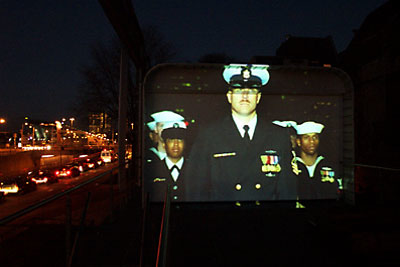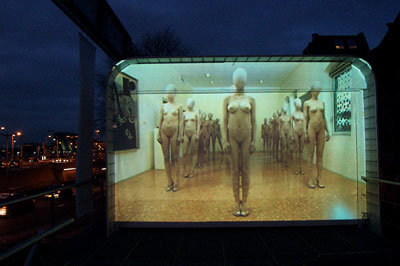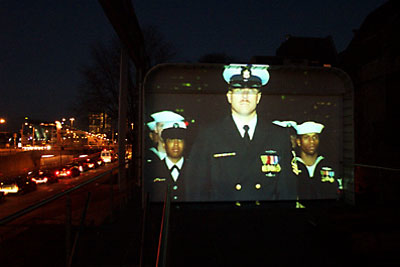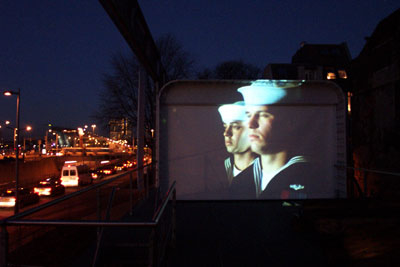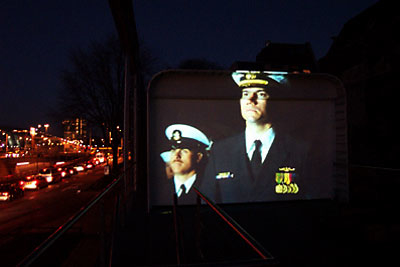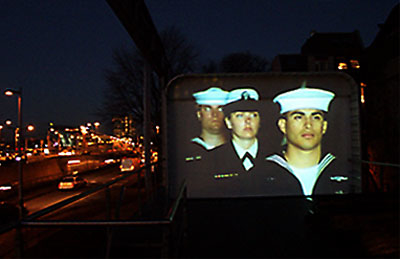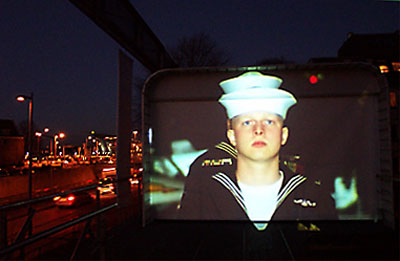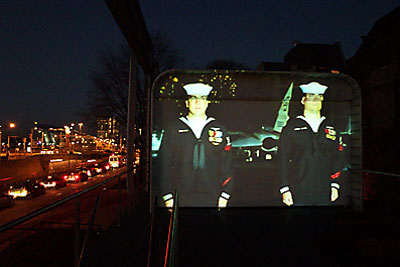But now and again we also get the impression of looking at paintings, and then again they appear to be dream figures. Images which have stepped out of the contours of her own form, briefly coming to life for as long as the performance lasts. For a moment they are just things you might call 'Beecrofts'. We have heard of this before, human types bearing the name of the artist who portrayed them first. Picasso-faces, Hitchcock-women, Modigliani-figures, Giacometti-silhouettes. And so now Beecroft-figures-in-movement. They are just irresistible.
Mediamatic Supermarket showed two pieces, The Silent Service (VB42) and Venice (VB47), from New Yorker Vanessa Beecroft’s steadily growing repertoire. She is not completely unknown in Amsterdam for she gave a performance in gallery Aschenbach already in 1993 (see the catalogue The Chalk-white Child, edited by A. Haselhoef, I. Willems, and Paul Groot, 1993). Venice is a surrealistic variation with a performance of naked girls in the Guggenheim Foundation in Venice, and is in keeping with moods reminiscent of the work of Giorgo de Chirico. The Silent Service portrays a line-up of marines on a museum warship in San Diego harbour.
Here, Beecroft has combined filmic, artistic and everyday experiences in an atmosphere as delicate as it is superior. Equally fragile as they are challenging are the performance on the aircraft carrier (in the evening where the crew in formation are lined up as if briefly caressed by the wind), and the one in Venice (where the performers – girls 'without faces' – are arranged as still as shop dummies, bent into a few basic positions as if by an invisible hand). We all occasionally dream of statues coming to life, but here we see the opposite, people who become statues, a rarer variation. More hysterious, frightening too, something that the biblical figure of Lot who turned into a pillar of salt may bear witness to.
In spite of the fact that Beecroft films her performances in broad cut, both films are characterised by a view operating within an artistic framework with, historically, a vivid past: Raphael’s cardinals devising their nefarious plans, Jan van Eyck’s Flemish priests, Rembrandt’s self-portraits, all may be traced here.
Venice (VB47)
Venice tells the story of a performance of faceless girls. Figures that reveal themselves in their almost unprotected physicality, are seen without they themselves looking back. They can look through their mask, but remain faceless to the onlooker. They are not blind, but they perform with a countenance hidden behind a graceful, egg-shaped helmet. The Greek goddess Athena was born with a helmet on, these girls suggest something of that secrecy. The faces are like mannequins on a De Chirico canvas, like egg shells. The bodies of the young, naked maidens wear an unmistakable badge: preferably stand still and move as you do in this day and age. They are grouped together in a little hall in the Guggenheim Foundation in Venice, with world class paintings on the wall, and windows with beautiful, classic window panes. Young girls, clearly rather insecure in their nakedness, but gradually you see them assume a rather more relaxed attitude, stretch their legs, evidently because they are not used to the high heels they wear. They stand in formation, sit down one after another on the marble floor.
Perhaps the secret of Beecroft’s work is mainly that which we don’t see. The girls are nude, smooth shaven, and look like each other. That challenges, fascinates and keeps our gaze excited. But at the same time, we dream of the moments that the faces hidden by their masks from our eyes, come to life, put on their clothes again and change from anonymous figures into living girls. Perhaps we imagine their giggling before and after the performances.
Has Beecroft’s work ever been linked with pornography? In any case a view of her work is not secure against scabrous thoughts. But at the same time it is as if in her view all passion, desire and ardour are neutralised here into, yes, into art. As if the girls are on neutral territory, and the onlooker just as the gamesters are forced into submission, to a neutral dispassionate submission.
However that may be, viewed artistically this is an unparalleled ‘warehouse’ of movements and behaviours on a square millimetre, that floors you as a viewer. Like a museum room with statues of, be generous, Giacometti, a Brancusi, with portraits of Bronzino and Rafael on the wall, bedecked with an anonymity that has only really become an artistic motive since De Chirico.
This celebration is best approached with the thought of a collection of Greek statues, or by an attic with casts of those statues for academic students, somewhere in the nineteenth century. A nightmare, or a really quite heavenly dream: all the statues come slowly and sluggishly to life, as if the girls have been sedated by a collective drug.
At a certain moment they are all sitting with their legs folded, stretched out, apart or together on the ground, hands resting on the floor. The heads occasionally go back and forth, they look at us, see us, we cannot see them. Languorous maidens matching the skin toned marble floor beautifully.
Shop dummies sitting wonderfully, one supporting her head on her hand, a fantastic image, uncommonly fragile. This is more than sculpture, this is first class dance. And look at that girl with her back towards us. As if Ingres’ Odalisque has come to life again!
One of the most beautiful moments is perhaps when a group of girls during the second part of the film move to a room with Jackson Pollock paintings on the wall. Anyone who has seen Ed Harris’ film about the painter, who died in a car accident at the age of 44, will not be able to look at this without tears. How Pollock would have enjoyed this scene if he had had a chance of ever seeing it! Five gorgeous girls on a leather sofa admiring several canvasses painted by him. That is so surrealistic: a work of art looking at art, quite bizarre! If Pollock had been able to look at this picture in real life, I am willing to bet that he would have been completely stunned.
Too good to be true!
The silent service (VB42)
The story is simple: a group of marines in full uniform drawn up on an aircraft carrier in San Diego harbour. Beecroft positions herself as a high-ranking guest who proclaims herself and inspects the troops. The eye goes back and forth, the men and women initially stand as if petrified, only the wind causes clothing to move. And then further details, the faces of sternly gazing men and women, with eyelids that blink often, who are conscious that they are becoming art or a part of Hollywood through this registration, The crew slowly thaw, the men and women are more vulnerable than you at first thought, they quickly become a little familiar. The wind attempts to pull it all out of balance by playing a game with the military decorations. Then the crew move back and forth too.
When they perform there they look stern, they behave toughly, but we gradually see through them very well. Under Vanessa Beecroft’s direction the marines move as if in a production never previously seen, not a tattoo, not a parade, not a film, and in spite of suggestion not a painting or sculpture either. Their precision and rigorousness is transparent here, their effectiveness primarily acted. But make no mistake: Milosevic and Sadam Hussein know better. If these boys and men are allowed free rein, they sow death and destruction for their noble cause.
Translation: Helen-Anne Ross^^
